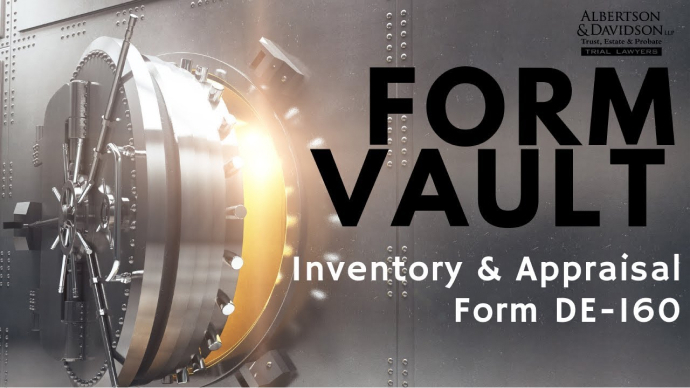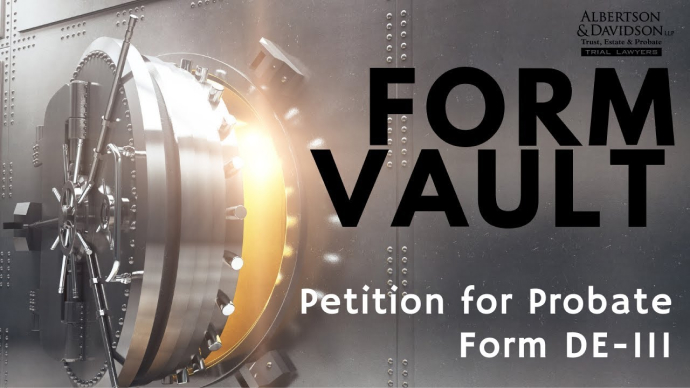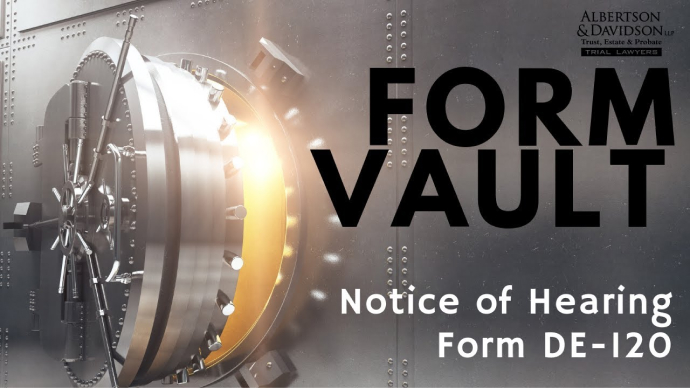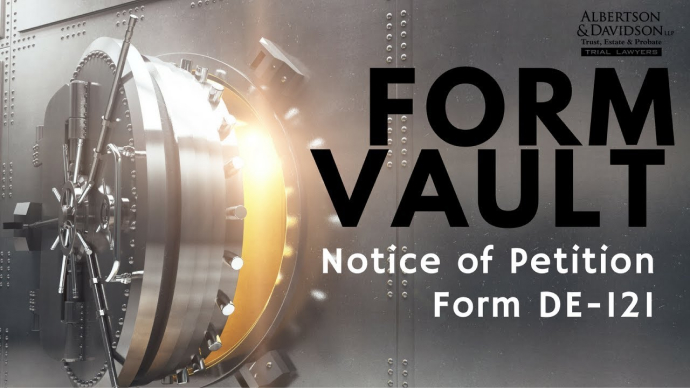Video Transcript
The following is an unedited, verbatim transcript of our video. It is not intended to be a stand-alone article.
Hi, this is Keith Davidson of Albertson & Davidson. In this video, I’m going over the Inventory and Appraisal form that you will need anytime you do a Probate. If your probating a Will or probating an Estate that doesn’t have a Will, what we can an Intestate estate, you will have to file an inventory and appraisal with the court. So let’s take a look at what this form is.
We’re going to start at Google and just put in judicial council forms and we’ll go to the court’s website, and then we’re going to want to toggle down to the Probate – Decedent’s Estates, that’s where all the form are that we want to use. And then we’re going to go down to form DE-160, and that’s the inventory and Appraisal. Now, form DE-160 is interesting because you do have to fill out all of the Estate information on it. All of the assets that you know about. But, every time you do an inventory and appraisal, you have a choice, you don’t have to necessarily do a final inventory and appraisal, you can do what we call a partial inventory and appraisals, meaning you can appraise one asset and you can appraise another asset. The reason why they allow that is because some assets take longer to appraise than others. And so sometimes, you want to do an appraisal of the easy items first and file that with the court so that everybody knows what’s happening, and then you can do the more difficult items as time permits.
We’re going to start off here by putting in our name and address information. So if you’re doing this, you don’t have an attorney, you would just put pro per after your name. But for those of us who are attorneys, we would put in our name and our state bar number, and then put in your law firm name of course, and all of the address information. You also will put in your phone number, fax number, email address, all of that good stuff. I’m not going to spend the time doing it here, but you certainly can, and then you’re going to put who you represent. So again if you’re doing this on your own, you can just put your name Keith Davidson representing Keith Davidson, but if you’re an attorney, you’ll put in the name. And then we need the court information, so whatever county you’re in, you would go ahead and type that in here, and then go to the court’s website, find the street and mailing addresses, and sometimes they are different, so make sure you get the right ones and then just make sure you include them in your form. And then you’re going to put in the branch name if you know it. If you don’t know it, you can go look it up, if you still can’t find it, you can just leave it blank.
This is going to be the Estate of Bob Smith, and we’re going to call it Decedent. You’ll notice that you also have the choice of Conservatee or Minor. An Inventory and appraisal is used in conservatorships and guardianships too. It’s the same form, works the same way, we just happen to be doing an estate so we’ll click the Decedent box. And then you’re going to put the case number where you want to have this filed in. Make sure you have the right case number. And they want the date of death of the decedent if you’re dealing with an estate or the appointment of the guardian or conservator if you’re dealing with the conservatorship or guardianship. So, we’re dealing with the decedent so we’re going to put in the date of death of October 1st 2018.
Partial, Final, Supplemental, Corrected, Reappraisal for Sale or Property Tax Certificate
Now the form wants to know is this a partial inventory, a final, a supplemental, a corrected, a reappraisal for sale, or a property tax certificate. Most of the time you’re either going to be doing a partial or a final, that’s the most common choices. Sometimes, people will do a supplemental, sometimes there will be a correction, and sometimes it will be re-appraised for sale. Whatever the situation is, you’ll notice the part comes with this little box over here, you’ll have to say it’s a partial number, whatever number it is. So if this is the first one you’re filing, it’d be partial number one, if it’s the second one, it’s two. I’ve seen estates where they’ve had six, seven, eight partials before they get to a final. Just depends on the complexity of the Estate.
Now up here where you have the appraisal, you’ll notice that it says total appraised by representative, guardian or conservator on attachment 1. That’s what the personal representative is going to appraise themselves, and there’s really only one thing the personal representative can appraise him or herself, and that is cash, and that’s it. The personal representative is not allowed to appraise anything else, not even marketable securities. So you might have a hundred shares of Apple and you might be able to go to the stock listings and figure out what those hundred shares of Apple are worth on the date of death, but you still can’t appraise that. The probate referee has to appraise that for you, only cash, so that’s what item number 1 attachment 1 is going to be. Number 2 is the total appraised by the referee attachment 2, and again that’s what the referee is going to do for you. You will be assigned a referee by the court when you open your probate matter, and that’s the person you’re going to have to send this form to once you’re done filling this out. You’re not going to fill out these amounts right now, these amounts will be filled out later on once the assets are appraised.
Now we’re going to go down here, so attachments 1 and 2 together with all prior inventories filed to contain a true statement of all or a portion of the estate, so this is where you need to state that either these are all the assets or these are only partial list of the assets.
Number 4 is pretty rare, this is where no probate referee is required. I supposed if you had an estate that literally is only cash, then you could click that, or if there’s a special circumstance and the court orders that there is no probate referee required. It very rarely happens.
The court does want to know about the bond, so if there’s a bond, you’re going to want to list that here. The reason why the court wants to know about the bond on inventory and appraisal is because the bond is typically set based on the value of the estate. So if you started off the estate with a bond of $10,000.00 but it turns out that you have a $100,000.00 of liquid assets, then the courts are going to want to increase the bond, and so you have to put that down here. So for example, the bond filed in the amount of $10,000.00 would either be sufficient or insufficient based on this appraisal, so the court wants to know about the bond.
Declaration by the Probate Referee
And then we have the declaration by the probate referee, so this is where the probate referee is going to sign the form saying that everything that he appraised or she appraised on attachment 2 is true and correct. So there’s a lot going on on this form. It’s a really simple looking form but you as the personal representative have to sign your piece, you have to sign a piece about the bond, and then the probate referee has to sign their piece, so a lot of different people have to sign this stuff saying you know that everything is proper.
Now let’s go back to the forms and we’ll take a look at what the attachments are. And so that’s going to be inventory and appraisal attachment form DE-161. So you notice that it has an attachment number up here and it’s blank, so this is the same attachment form that both the personal representative and the probate referee are going to use. So if you have some cash, this will be attachment 1, and you’ll just list the bank information. So let’s say you have a Bank of America checking account and you’ll put the description of that there, and let’s say it has $5,000.00, you’ll list that there, and then that’s going to be it, that’s all you’re going to have on this form. If however, you’re sending this off to the probate referee because the probate referee has to appraise everything else that’s not cash, then up here, you’re going to put attachment number 2 because that’s what the probate referee appraises. And then you’re going to start listing out all the assets, so for example, maybe you have a building, it’s part of the estate, I’m going to use our address as an example, I need to have this appraise because it’s a real property, so I’m going to put a description of it here, and then I’m going to leave the value blank because the probate referee will fill that in. And then if I have something else, I’m going to list that here and I might say a hundred shares of Apple stock, and I’m going to leave that blank because that really is up to the probate referee to fill in the values, and I’m going to just keep on going, I’m going to list every single asset that’s part of this estate. And then I’m going to mail the entire form along with this attachment to the probate referee and the probate referee is going t come through and fill out these values for me and then send it back to me and with the signature. So once the probate referee does their part, then they’re going to put the total amount of statutory commissions and expenses that they’re owed, and they’re going to sign this. So they’re going to give you back this signed and the attachment with all the values filled out. You’re going to use those values that they give you to fill out number 2 which is the total amount of assets on attachment 2, and that will be the value that you put in here. You can’t do that until the probate referee gives you the form back. Also, the statutory commission is based on a percentage of the assets, so the probate referee gets paid a percentage of what they appraised, and so the probate referee will tell you how much they’re entitled to in terms of a commission and whether or not they have any expenses that they’re entitled to have reimbursed. So this is a little bit of a team effort, you have to do your part, you have to send it off to the probate referee, the probate referee has to do their part, and then you’ll have a completed Inventory and appraisal that you can file with the court to establish what the beginning assets are for that probate estate as of the date of death.




